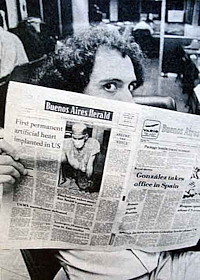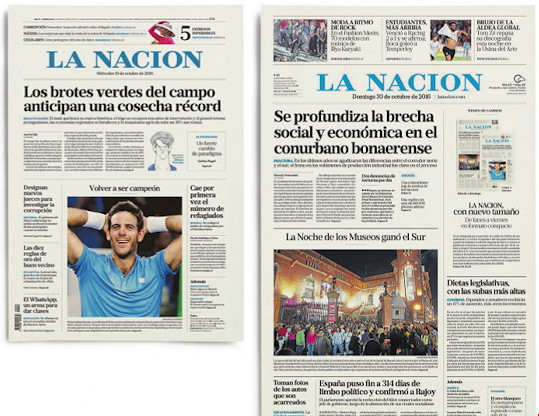
About Andrew Cusack
 Writer, web designer, etc.; born in New York; educated in Argentina, Scotland, and South Africa; now based in London.
Writer, web designer, etc.; born in New York; educated in Argentina, Scotland, and South Africa; now based in London. read more
News
Blogs
Reviews & Periodicals
Arts & Design
World
France
Mitteleuropa
Knickerbockers
Argentina
The Levant
Africa
Cape of Good Hope
Netherlands
Scandinavia
Québec
India
Muscovy
Germany
Academica
All Change for Argentine Newspapers
BsAs Herald emerges as weekly as La Nación goes tabloid

Not Lucas de Soto
One of the saddest pieces of news to hit the Cusackosphere in 2016 was word that the Buenos Aires Herald was ending its 140th year by moving from daily to weekly production. The English-language Herald has been a stalwart of its city and country and, though little known abroad, has ranked among the finest newspapers in the world. But from 2007, when Charleston’s Evening Post Publishing Company sold the Herald onwards to controversial businessman Sergio Szpolski, the paper found itself in increasingly chaotic situations. Robert Cox, Herald editor in the difficult period from 1968 to 1979, said what happened to the paper was “like a car crash”, and blamed the papers owners.
My favourite feature of the Herald was Martin Gambarotta’s weekly ‘Politics and Labour’ column — a witty and insightful peek behind the curtains of Argentine public life. Like Miriam Lord’s Dail sketches for the Irish Times, one wished it was possible to redeploy Gambarotta’s pen at will towards whichever corner of the globe one happened to be situated in.
As if that weren’t bad enough, the republic’s venerable broadsheet La Nación announced around the same time its conversion to a smaller compact size. The centre-right daily is the most prestigious in Argentina since the demise of La Prensa under Peronist persecution. While its weekend editions will maintain their broadsheet format, from Monday to Friday La Nación will be printed in a compact format similar in size to a tabloid.
Marcelo García’s explanation of the changes at the Herald can be found below.

The Herald, twice a victim
For The Herald — This collectors’ item you have in your hands is the last printed daily edition of this newspaper in a run that has lasted for over 140 years. Starting next week, the paper will not be a daily anymore, but a weekly. As the old journalism saying goes, no news is good news. And this piece of news comes with the worst of them all: most of the newsroom staff that fed you with information every morning are out of their jobs starting today.
The paradox is that this sad news is shocking but not surprising. The Herald is the latest victim of two phenomena that caught the paper off guard. One is universal: experts call it “the decline of a business model.” In plain English: nobody pays for the news anymore. The other is vernacular: Argentina’s media civil war.
When this weekly column, called Politics and the Press to follow in the footsteps of this paper’s traditional Politics and Labour, was first published in 2005, Facebook was just one year old and the digital realm we now live in was not even a toddler. Since then, almost every aspect of public life has changed. Most of the change has been for the better, with one change arguably not: trustworthy information is harder than ever to find.
Since 1876, the Herald has been an exception capable of confirming the premise that journalism is possible in Argentina. If a newspaper published in English could make ends meet and hit the newsstands every day, then the Spanish-language press could always hope for the light at the end of every tunnel. The darkest of those tunnels is by now legendary: Robert Cox and his newsroom charging at the windmills of corporate media silence (and complicity) during the brutal 1976-83 regime.
But for a newspaper like the Herald, daily existence has been heroic in itself, and its dramatic transformation and downsizing now is a(nother) call to attention for Argentina’s press corps, which has been too busy with its own fratricidal battle of factions over the last few years rather than concentrating on the larger war of guild survival.
The Herald was also a victim of Argentina’s irrational media war.
After 40 years of foreign ownership by the Charleston-based Evening Post, local business organizations with little to no journalistic background, born and raised under the wing of the Kirchner era, took hold of the newspaper. Sergio Szpolski’s Grupo 23 kept it for just one year from 2007-2008 and, upon selling it, stripped the paper of its iconic three-story building on Azopardo Street, the once Fleet Street of Buenos Aires. Since then, attached physically and in ownership to the financial daily Ámbito Financiero, the Herald became a pawn in a larger game that exceeded the energies of its dwindling newsroom found to keep on doing decent and honest journalism. It took Grupo Indalo, the new owner since February 2015, another year and a half to fold the paper’s daily newsroom tradition without putting up a real fight to save it.
It would be a mistake to attribute the Herald’s ill fortunes solely to the digital revolution of the highly politicized Argentine media jungle. While it is true journalism is not financially sustainable anywhere in the world, it is also true that in Argentina many publications have gotten used to making an easy living out of state advertising funds that were — and continued to be — distributed arbitrarily.
Is there a future for the Herald?
The company’s management has given little hint about what the future will bring for the newspaper. The official word has only come through two ads published after other media leaked the news about the decision. The ads called on readers to “Keep Calm” and celebrated the “Good News” that the new Herald will go to print weekly and come out on Fridays (mornings?), likely hoping to produce weekend reading material but (why not?) also to maximize the Group’s newspaper flagship Ámbito Financiero’s printing and distribution platform (Ámbito does not run on weekends).
But beyond the details of the transition to this unchartered ocean of the Herald’s long and eventful history, the main underlying question is whether the owners (present and future) will have a vision to try to turn weakness into strength. Upon announcing similar awful news earlier this year, the British newspaper The Independent made an incredible effort in spin to try to turn bad into good. We will be “the first national newspaper title to move into a digital-only future,” they wrote. The talking point was brilliant, even if the reality around it was not. Evidence in this new digital landscape shows that all merely cost-cutting drives are doomed to failure, and that having a digital change requires putting both heads and pockets into it.
Having a vision is the first step toward going somewhere, especially at a time when nobody knows where “somewhere” really is. It is hard to believe the only English-language newspaper in Latin America, one that reported on Argentina for almost a century and a half, with a reputation of honest, unbiased journalism, could not have a place in the cornucopia of digital noise around us. Forget about McLuhan: the media, print in this case, is not the message. The message, one that should be louder and clearer, is that someone out there still believes that having newsrooms to deliver the news matters.
Search
Instagram: @andcusack
Click here for my Instagram photos.Most Recent Posts
- Amsterdam November 26, 2024
- Silver Jubilee November 21, 2024
- Articles of Note: 11 November 2024 November 11, 2024
- Why do you read? November 5, 2024
- India November 4, 2024
Most Recent Comments
Book Wishlist
Monthly Archives
Categories


